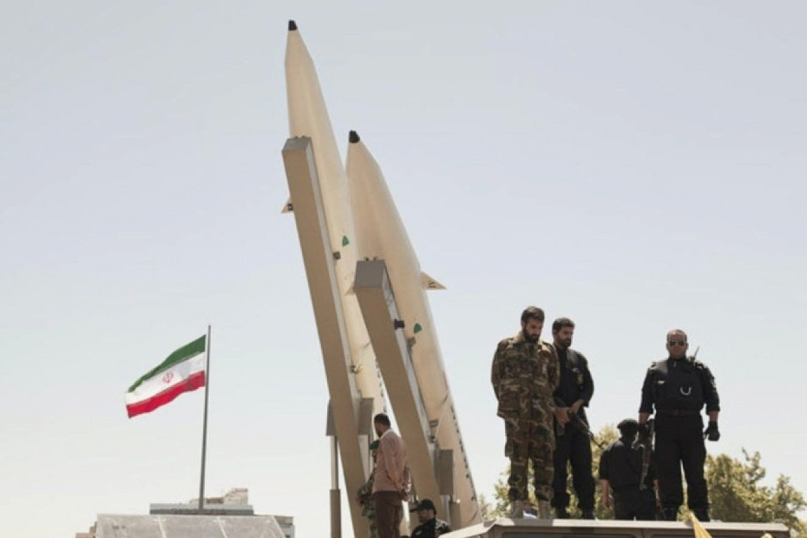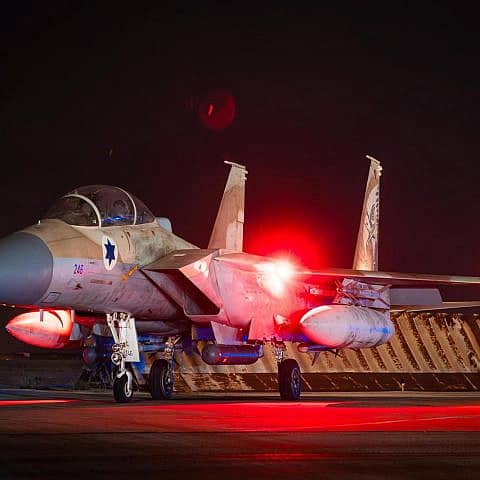
(JNS) Iran and its jihadist Middle Eastern axis sustained a resounding strategic defeat in recent hours.
The combined Iranian attack on Israel in the early hours of April 14, comprising 170 UAVs, 30 cruise missiles and 120 ballistic missiles—more than 300 aerial threats in total—was successfully intercepted by Israel and partner militaries.
The fact that 99% of the threats were intercepted means that a central pillar of Iranian force projection—its missile and UAV arsenals—has been proven to be no match for Israel’s Air Force, its multi-layered air defense system, or for regional cooperation with allies.
For decades, Iranian military industries have been developing and producing missiles and UAV capabilities. These capabilities were used to arm Iran’s elite military force, the Islamic Revolutionary Guard Corps, and Iran’s proxies.
While Iran often activates its proxies to attack its enemies, it has, until now, kept its own powder dry, based on the idea that the firepower Iran amassed on its own soil would keep Israel, Sunni Arab countries, and the United States deterred, and would stop Israel from acting too fiercely to disrupt Iran’s hegemonic plans.

Israel mulls response to Iranian attack April 14, 2024

Biden said to tell Netanyahu US won’t support Israeli response to Iran attack April 14, 2024

G7 leaders ‘unequivocally condemn’ Iranian attack in ‘strongest terms’ April 14, 2024
Iran plans to surround Israel with a network of terror armies, break through to nuclear weapons and use the combination of its proxies, conventional weapons and nuclear umbrella to cause Israel to collapse by 2040—according to the clerical regime’s own statements and officials. As such, its decision to directly attack Israel on Sunday represents a major departure from this long-term strategy.
After the April 1 strike on Damascus that killed the IRGC Quds Force commander for Syria and Iraq, Mohammad Reza Zahedi, his deputy and five other IRGC officers, Iran decided that the time was ripe to break with its pattern of using proxies to weaken Israel and keep it bogged down in conflict, and to directly “teach Israel a lesson.”
But it is Iran that has now learned that Israel’s multi-layered shield, fighter jets and partners can collectively neutralize its flagship conventional weapons program.
Israel’s multi-layered air defense system relies on the Arrow 3, which intercepts ballistic missiles in space, Arrow 2, which operates in the upper atmosphere against ballistic missiles, David’s Sling intermediate-range system, which intercepts heavy rockets and short-range ballistic missiles (of the type Iran and Syria have supplied to Hezbollah) as well as cruise missiles and drones, and Iron Dome, which shoots down rockets, cruise missiles and drones.
Israel is expecting its Iron Beam laser interception system, which can shoot down rockets, mortars and UAVs, to become operational soon, and is developing an interceptor (Sky Sonic) for Iran’s future hypersonic missile (Fattah), which is in development.
The Israeli Navy is also equipped with the advanced Barak 8 surface-to-air protection system, which can be activated from the sea.
Iran must now await Israel’s retaliation, and unlike Israel, Iranian air defenses are by comparison limited in scope.
After its own failure on Sunday, Iran now relies almost exclusively on Hezbollah for an ability to threaten Israel.
According to the IDF’s data, around 170 Iranian UAVs—a massive swarm—failed to cross into Israeli air space. Dozens were intercepted by IAF jets, Israel’s ground-based interceptors, and partner aircraft and air defense systems.
According to international media reports, American and British jets took part in interceptions, along with the Jordanian and Saudi air defense systems.
In addition, of the more than 30 cruise missiles Iran launched on Sunday, none crossed into Israeli territory.
Twenty-five of them were intercepted by IAF fighter jets outside the country’s borders, the IDF said. Out of over 120 ballistic missiles, only a few crossed into Israeli territory, with the rest being intercepted. The ones that impacted targeted the Nevatim F-35 Air Force Base in southern Israel, causing only minor damage to infrastructure. The base remains operational.
“Iran hoped to incapacitate the base and thus impair our aerial capabilities, but it failed. IAF aircraft continue to take off and land from the base and depart for offensive and defensive missions. This includes the ‘Adir’ [F-35] fighter jets, which are now returning to the base from an aerial defense mission, and you will soon see them landing,” IDF Spokesperson Rear Adm. Daniel Hagari stated on Sunday morning.
In addition to the launches from Iran, several launches occurred from Iraq and Yemen on Sunday—but none of them crossed into Israeli territory, Hagari said.
A seven-year-old Bedouin-Israeli girl was severely injured by shrapnel in the Negev and is being treated in hospital.
Hezbollah, for its part, remained in its usual low- to medium-intensity wartime mode, firing dozens of rockets from Lebanon in recent hours, and absorbing strikes by IAF jets.
The IAF’s Aerial Defense Array as well as aircraft pilots have been preparing for this moment for years.
Iran fired extremely dangerous threats at Israel on Sunday. Its ballistic missile attacks likely included projectiles with very large warheads, each one of which can destroy multiple buildings on impact, if not intercepted. Iranian media claimed the attack included Kheibar Shekan ballistic missiles, which have a warhead of 500 kilograms (1,100 pounds).
The IDF chief of General Staff, Lt. Gen. Herzi Halevi, directed the defensive air battle together with IAF head Maj. Gen. Tomer Bar and other senior commanders from the Israeli Air Force’s Operations Center at the Kirya IDF headquarters in Tel Aviv.
Just as Iran dropped its mask and revealed its fanatical intentions on Sunday, so too did Arab states in the region that are badly threatened by Iran reveal their intentions to push back against Iran, according to international media reports.
If Saudi Arabia took part in interception activities, this would not be the first time.
In November 2023, Saudi Arabia reportedly intercepted a ballistic missile fired from Yemen, by Iran-backed Houthis, at Israel.
Several factors enable this cooperation. The existing framework of U.S.-Israeli missile defense collaboration, built over three decades, Israel’s entry in 2021 to the U.S. Military’s Central Command (CENTCOM, which is responsible for the Middle East) area of operations, and sales of American Patriot and Terminal High Altitude Area Defense (THAAD) systems to Saudi Arabia all make such cooperation possible.
“Over the past six months, we have been operating in close coordination with our partners, led by U.S. CENTCOM, the U.K., France and other countries that operated last night. This partnership has always been robust, but last night it was exceptionally evident,” said Hagari on Sunday.
In this context, it is important to note decades of joint Israeli-American research and development on all Israeli air defense systems (except Iron Dome), the integration of radars and interceptors across the Middle East and the building of an intricate web of information-sharing.
On this network, American sensor data from various sources is fused and shared with Israel, and vice versa.
This likely includes data from American satellite assets, and radars stationed in places like Turkey, Qatar and Israel, which can nourish Israeli interceptors, along with Israel’s own extensive radar and sensor network.
The network could well include Saudi and Jordanian sensors. Two U.S. Navy ships in the eastern Mediterranean shot down at least three ballistic missiles using the Aegis missile defense system, according to CNN, while U.S. fighter jets also shot down Iranian aerial threats.
As such, a defense architecture that has been assembled for years by the United States, Israel and Arab states shined on Sunday.
Looking ahead, an Israeli response against Iran looks like a certainty. The fact that Iran launched its attacks from its own soil means that Israel will direct its response at targets on Iranian soil.
Israel has a range of options at its disposal. The Israeli War Cabinet will have to balance its response options against Iran with the need to move in on Hamas’s last bastion of Rafah in Gaza, and a potential escalation with Hezbollah in Lebanon. These factors will help shape the Cabinet’s dilemma: Choosing between limited retaliatory strikes, which themselves could attract further Iranian attacks, or broader operations that could even target Iran’s nuclear program.
Israel must pursue its core security interests based on the realization that international legitimacy is fickle, waxing and waning in the space of days and even hours. If Israel makes good on its duty to fight back against its enemies, its allies will respect it more, despite public posturing.







 Southern New England Jewish Ledger
Southern New England Jewish Ledger













